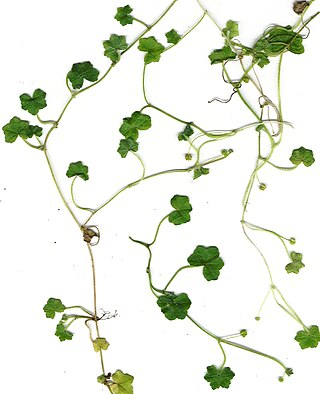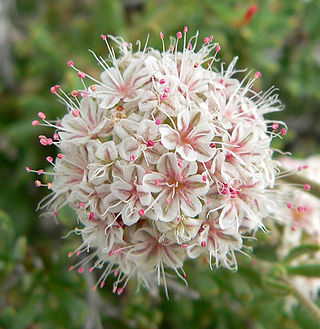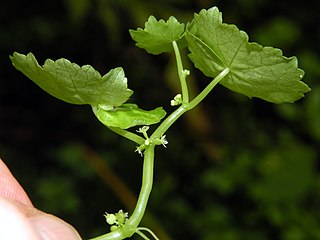
Pennywort is a common name given to several different plants around the world. In general they have round leaves and a low-growing habit. Pennywort may refer to:

Ribes malvaceum, the chaparral currant, is a member of the Grossulariaceae. It is native to California and northern Baja California, where it occurs from sea level to 1,500 metres (4,900 ft), in chaparral, foothill oak woodland, and closed-cone pine forest habitats.

Hydrocotyle, also called floating pennywort, water pennywort, Indian pennywort, dollar weed, marsh penny, thick-leaved pennywort and white rot, is a genus of prostrate, perennial aquatic or semi-aquatic plants formerly classified in the family Apiaceae, now in the family Araliaceae.

Eriogonum fasciculatum is a species of wild buckwheat known by the common names California buckwheat and flat-topped buckwheat. Characterized by small, white and pink flower clusters that give off a cottony effect, this species grows variably from a patchy mat to a wide shrub, with the flowers turning a rusty color after blooming. This plant is of great benefit across its various habitats, providing an important food resource for a diversity of insect and mammal species. It also provides numerous ecosystem services for humans, including erosion control, post-fire mitigation, increases in crop yields when planted in hedgerows, and high habitat restoration value.

Hydrocotyle ranunculoides, known commonly as floating pennywort, or floating marshpennywort, is an aquatic plant in the family Apiaceae. It is native to North and South America.

Vinca major, with the common names bigleaf periwinkle, large periwinkle, greater periwinkle and blue periwinkle, is a species of flowering plant in the family Apocynaceae, native to the western Mediterranean. Growing to 25 cm (10 in) tall and spreading indefinitely, it is an evergreen perennial, frequently used in cultivation as groundcover.

Anemone hepatica, the common hepatica, liverwort, liverleaf, kidneywort, or pennywort, is a species of flowering plant in the buttercup family Ranunculaceae, native to woodland in temperate regions of the Northern Hemisphere. This herbaceous perennial grows from a rhizome.

Hydrocotyle verticillata, also known as whorled pennywort, whorled marshpennywort or shield pennywort, is a flowering plant found in South and North America and the West Indies. Its creeping habit and unusual leaves give it its common names. It grows in places that are marshy, boggy, or even wet.
Hydrocotyle verticillata is used in aquaria, where it is undemanding; it does prefer a good substrate, however, and at least moderate light. It benefits from additional carbon dioxide. It is widely used as a foreground plant.

Hydrocotyle vulgaris, the marsh pennywort, common pennywort, water naval, money plant, lucky plant, dollarweed or copper coin, is a small creeping aquatic perennial plant native to North Africa, Europe, the Caucasus and parts of the Levant.

Grindelia hirsutula is a North American species of flowering plant in the family Asteraceae known by the common names hairy gumplant and hairy gumweed.

Acmispon argophyllus, synonym Lotus argophyllus, is a species of legume native to California and northwest Mexico. It is known by the common name silver bird's-foot trefoil or silver lotus.

Diplacus whitneyi is a species of monkeyflower known by the common name Harlequin monkeyflower. It was formerly known as Mimulus lewisii. It is also known as Diplacus bicolor.

Hesperocyparis stephensonii is a species of western cypress known as the Cuyamaca cypress that is found only in two very small areas in Southern California and northwestern Baja California.
The Burrinjuck Nature Reserve is a protected nature reserve on the south west slopes of New South Wales, Australia. The 5,250-hectare (13,000-acre) reserve is located adjacent to the Burrinjuck Dam, with 5,118 hectares of the reserve located on the northern side of the reservoir, and the remaining 89 hectares located on the southern side of the reservoir to the northeast of Black Andrew Nature Reserve. It includes land formerly managed as the Burrinjuck State Forest and Burrinjuck State Recreation Area.

Fritillaria biflora var. ineziana, the Hillsborough chocolate lily, is a species of fritillary endemic to San Mateo County, California. It grows on serpentinite in cismontane woodland and valley and foothill grassland at elevations that range from 295 to 525 feet It is typically found on serpentine soils, and it is defined as a "broad endemic" where 85-94% of occurrences are expected to occur on ultramafic soils.
Hydrocotyle hirta, commonly known as the hairy pennywort, is a species of flowering plant in the family Araliaceae native to Australia.

The Hūnua Falls are on the Wairoa River in the Auckland Region of New Zealand, near Hūnua. The land around was bought by Auckland for water supplies between 1940 and 1960. The mean flow of water downstream at Clevedon is 2.6 m3 (570 imp gal)/s, but can vary greatly, as illustrated in photographs showing the falls in winter and summer.

Hydrocotyle americana is a small plant native to the Northeastern United States. It is commonly referred to as American marshpennywort or navelwort and American water-pennywort. H. americana grows from Ontario to Newfoundland south through the Appalachian mountains to South Carolina. H. americana has been introduced to South Africa as well as New Zealand.

Acanthoscyphus is a monotypic genus in the family Polygonaceae that contains the single species Acanthoscyphus parishii, which is sometimes called Parish's oxytheca. This species is native and endemic to southern California.

Hydrocotyle phoenix is a species of annual pennywort and is commonly called fire pennywort. It is only known to grow in south-west Australia, specifically in fire prone habitats; it is unique in this regard as it is the only species of Hydrocotyle known to have a fire adapted life-history. The specific epithet "phoenix" references this fire adapted life history as in Greek mythology, a phoenix experiences rebirth by rising from ashes, much like how this plant rises from the ashes after a wildfire.


















